Compact Sportage makes large impression
Filed under: Equinox, Weekly test drives, Autos
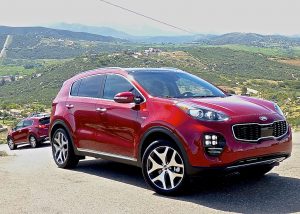
The 2017 Kia Sportage showed its turbocharged flair in the Southern California mountains, but is equally at home on suburban roadways.
By John Gilbert
It’s difficult enough for a car-maker to try to compete in the most intense segment in the industry, but for Kia it’s even more of a challenge, because it had to additionally compete with Hyundai, its South Korean partner and benefactor, before coming out with the 2017 Kia Sportage.
Compact crossover SUVs are currently the rage in automotives, and finally we’ve got a trend that makes sense. If larger or midsize SUVs have more space than cars and can haul everything at once, they also cost more money, require larger engines and therefore suffer when it comes to fuel economy, and they are more difficult to drive in congested traffic, let alone park.
The trend a decade ago to downsize from large SUVs to midsize was, therefore, logical and made economic sense. Whne the trend continued, down from midsize to compact crossover SUVs (CUVs), they proved enormously popular. If the room is adequate, the compacts could boast of much better sticker prices, and sportier handling with smaller, peppier and more fuel-efficient engines.
A perfect example is the 2017 Kia Sportage, the compact little brother to the solidly entrenched midsize Kia Sorento. It is a parallel vehicle to Hyundai’s Tucson, but there are significant differences, leaving both with distinct advantages.
Hyundai took over Kia almost a decade ago, and the two have been raised as separate but equal companies, both benefitting by the other’s successes. Hyundai was on the verge of an engine-making breakthrough right about then, and Kia came along with some equally brilliant design ideas. That helped make it more of a merger than a takeover, and both kept turning out exceptional vehicles from the smallest compact cars up through luxury vehicles, and with SUVs that filled all the required gaps. Read more
Late summer lets Fiat 124 Spider roll
Filed under: Weekly test drives, Autos
By John Gilbert
When summer lingers into fall, and summer-like days reach into November, it’s the time fond memories are rekindled. Similarly, whenever the term “sports car” is mentioned in my presence, I slip into an instant reverie about a curvy roadway on an autumn afternoon, sunshine everywhere and colored leaves scattered all around.
Into that pastoral scene comes a two-seat roadster, top down, engine smoothly sounding out its powerful potential while being kept within the restraints of a light right foot. As the roadster approaches, it carves the curvature of the roadway perfectly, and as it passes, it leaves a swirling wake of blowing leaves.
Now THAT’S what a true sports car should be. It’s always been that way in my mind, and this autumn of 2016 is the perfect scenario, because in the Northland, instead of Gales of November, we’re all pretty astonished that we’re watching thermometers rise into the 60s.
If it’s a perfect scenario for a roadster, there also are a couple of roadsters that perfectly fit the scene as well. We all know and love the Mazda MX-5 Miata, the most enduring affordable sports car on the planet. And the newly redesigned Miata now has a sibling, in disguise this time around — the Fiat 124 Spider.
Back when Fiat used to send cars to the U.S. in the 1960s, one of the most popular was the Fiat 124, both in coupe and roadster form. The coupe was a 2-plus-2 with an actual rear seat. The roadster, however, was the Spider — a true sports car, with a soft top that could be stowed behind the two bucket seats, and a willing and great-sounding 4-cylinder engine.
Fiat is making its return to the U.S., with its little compact 500 sedan, and all its derivatives, and now, for 2017, the return of the 124 Spider. To create the new Spider, Fiat worked out a deal with Mazda for the new MX-5 Miata platform. But it wasn’t content to just rebadge the Miata and use its splendid Skyactive 4-cylinder engine. Instead, Fiat pulled out its own 1.4-liter 4-cylinder from the Fiat 500 Abarth pocket-rocket, and fitted it into the new 124.
Read more
Hellcat is ultimate Challenger big-boy toy
Filed under: Weekly test drives, Autos
By John Gilbert
Dodge intends to end production of the Viper sports car when the currentBu supply runs out. But if it’s painful to accept that the Viper’s time has elapsed, so to speak , it’s easier to accept if you’ve driven the Dodge Challenger SRT Hellcat.
The two-seat Viper has an overwhelmingly powerful 8.4-liter V10 engine delivering 645 horsepower and 600 foot-pounds of torque, but it can’t match the bark, or the bite, of the Challenger Hellcat. Lighter and leaner, the 2-plus-2 Challenger has a highly refined 6.2-liter Hemi V8, supercharged to generate 707 horsepower and 650 foot-pounds of torque, meaning the Challenger Hellcat’s bite makes it the most powerful production car in the country.
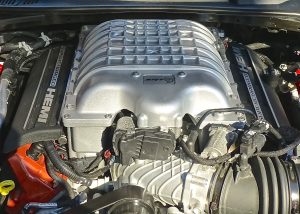
Hellcat’s heart is a 6.2-liter supercharged Hemi V8, with 700 horsepower and 650 foot-pounds of torque.
No less impressive is its bark. Turn it on, and the Challenger Hellcat will turn you on, with a soul-stirring roar that shakes the ground and rattles the walls and leaves you smiling with relief, knowing you didn’t blow out any of the neighborhood windows.
The Viper is a harsh, no-compromise brute, while the Challenger can be bought mild, with a supple suspension under the base 3.6-liter V6, or the 5.7 or even 6.4 ScatPak V8s. But when you select the SRT Hellcat’s supercharged and specially built 6.2 liter V8 gem, you are at the pinnacle.
The Challenger is Dodge’s future-retro coupe that as a faithful reproduction of the 1970s Trans-Am coupes, clearly beats both the Mustang and Camaro. It also has become the largest-selling car in Dodge’s livery. To beat the competition in performance will cost you, of course.
In basic V6 form, a Challenger provides the same look for under $30,000. Moving up past the normal Hemi to the Hellcat moves the sticker price up, and up again, to $62,495. The stunning red Hellcat as-tested during a week on the North Shore of Lake Superior and the cliffs of Duluth was an SRT Hellcat with a sticker of $71,370. That is still $25,000 or so less than the most basic Viper, however, and it fills up all your known senses and lets you discover a few you didn’t know you had. Read more


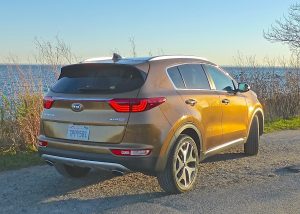
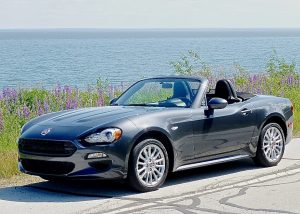
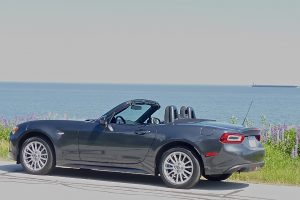
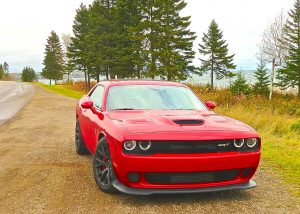
 John Gilbert is a lifetime Minnesotan and career journalist, specializing in cars and sports during and since spending 30 years at the Minneapolis Tribune, now the Star Tribune. More recently, he has continued translating the high-tech world of autos and sharing his passionate insights as a freelance writer/photographer/broadcaster. A member of the prestigious North American Car and Truck of the Year jury since 1993. John can be heard Monday-Friday from 9-11am on 610 KDAL(www.kdal610.com) on the "John Gilbert Show," and writes a column in the Duluth Reader.
John Gilbert is a lifetime Minnesotan and career journalist, specializing in cars and sports during and since spending 30 years at the Minneapolis Tribune, now the Star Tribune. More recently, he has continued translating the high-tech world of autos and sharing his passionate insights as a freelance writer/photographer/broadcaster. A member of the prestigious North American Car and Truck of the Year jury since 1993. John can be heard Monday-Friday from 9-11am on 610 KDAL(www.kdal610.com) on the "John Gilbert Show," and writes a column in the Duluth Reader.